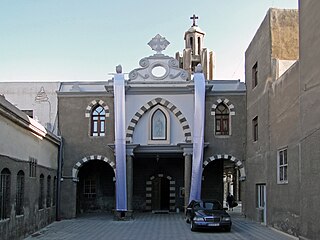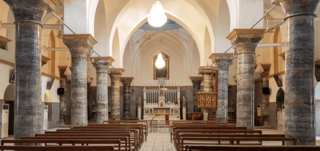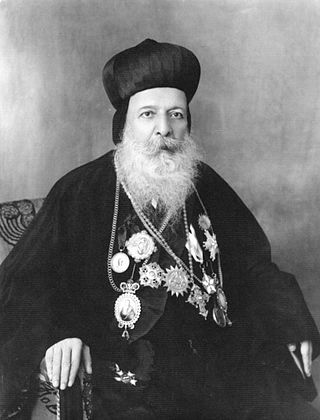Related Research Articles

The Syriac Catholic Church is an Eastern Catholic Christian jurisdiction originating in the Levant that uses the West Syriac Rite liturgy and has many practices and rites in common with the Syriac Orthodox Church. Being one of the twenty-three Eastern Catholic Churches, the Syriac Catholic Church is a self-governed sui iuris particular church, while it is in full communion with the Holy See and with the entirety of the Catholic Church.

The Assyrian Church of the East (ACOE), sometimes called the Church of the East and officially known as the Holy Apostolic Catholic Assyrian Church of the East, is an Eastern Christian church that follows the traditional Christology and ecclesiology of the historical Church of the East. It belongs to the eastern branch of Syriac Christianity, and employs the Divine Liturgy of Saints Addai and Mari belonging to the East Syriac Rite. Its main liturgical language is Classical Syriac, a dialect of Eastern Aramaic.

Mor Ignatius Zakka I Iwas was the 122nd reigning Syriac Orthodox Patriarch of Antioch and All the East and, as such, Supreme Head of the Universal Syriac Orthodox Church. Also known by his traditional episcopal name, Severios, he was enthroned as patriarch on 14 September 1980 in St. George's Patriarchal Cathedral in Damascus. He succeeded Ignatius Ya`qub III. As is traditional for the head of the church, Mor Severios adopted the name Ignatius.

The Chaldean Catholic Church is an Eastern Catholic particular church in full communion with the Holy See and the rest of the Catholic Church, and is headed by the Chaldean Patriarchate. Employing in its liturgy the East Syriac Rite in the Syriac dialect of the Aramaic language, it is part of Syriac Christianity. Headquartered in the Cathedral of Our Lady of Sorrows, Baghdad, Iraq, since 1950, it is headed by the Catholicos-Patriarch Louis Raphaël I Sako. According to a 1950 CIA report on Iraq, Chaldean Catholic Assyrians numbered 98,000 and were the largest Christian minority. In the late 2010s, it had a membership of 616,639, with a large population in diaspora and its home country of Iraq.

Mar Dinkha IV, born Dinkha Khanania was an Eastern Christian prelate who served as the 120th Catholicos-Patriarch of the Assyrian Church of the East. He was born in the village of Darbandokeh (Derbendoki), Iraq, and led the Church in exile in Chicago for most of his life.

Mār Yōsip Khnanisho, the twelfth Metropolitan or Matran of Shemsdin from 1918 to 1977.
Mar Gewargis III served as the 121st Catholicos-Patriarch of the Assyrian Church of the East. On 18 September 2015, the Holy Synod of the Assyrian Church of the East elected Mar Gewargis Sliwa to succeed the late Mar Dinkha IV as the head of the Church. On 27 September 2015, he was formally consecrated and enthroned as Catholicos-Patriarch.
The Nochiya are an Assyrian tribe that were based in and around the district of Şemdinli, in the province of Hakkari, Turkey.

Christianity has a long and continuous history in Lebanon. Biblical scriptures show that Peter and Paul evangelized the Phoenicians, leading to the dawn of the ancient Patriarchate of Antioch. As such, Christianity in Lebanon is as old as Christian faith itself. Christianity spread slowly in Lebanon due to pagans who resisted conversion, but it ultimately spread throughout the country. Even after centuries of living under Muslim Empires, Christianity remains the dominant faith of the Mount Lebanon region and has substantial communities elsewhere.

Mor Ignatius Jacob (Yaʿqub) III was the 121st Syriac Orthodox Patriarch of Antioch and head of the Syriac Orthodox Church 1957–1980. He was skilled in and knowledgeable in Syriac sacral music or Beth Gazo. He re-established the Maphrianate/Catholicate in the Jacobite Syrian Orthodox Church.

The Assyrian homeland, Assyria, refers to the homeland of the Assyrian people within which Assyrian civilisation developed, located in their indigenous Upper Mesopotamia. The territory that forms the Assyrian homeland is, similarly to the rest of Mesopotamia, currently divided between present-day Iraq, Turkey, Iran and Syria. In Iran, the Urmia Plain forms a thin margin of the ancestral Assyrian homeland in the north-west, and the only section of the Assyrian homeland beyond the Mesopotamian region. The majority of Assyrians in Iran currently reside in the capital city, Tehran.

Mor Ignatius Aphrem I Barsoum was the 120th Syriac Orthodox Patriarch of Antioch and head of the Syriac Orthodox Church from 1933 until his death in 1957. He was consecrated as a Metropolitan and as a Patriarch at a very hard time for the Syriac Orthodox church and its people and parishes and he worked very hard to re-establish the church initiations to where his people moved. He researched, wrote, translated, scriped, and published many scholarly works that included books on the saints, tradition, liturgy, music, and history of Syriac Orthodox Church.

Assyrians in Lebanon, or Assyrian Lebanese, are people of Assyrian descent living in Lebanon. It is estimated that there are approximately 30,000 Assyrians currently residing in Lebanon, primarily in Beirut and Zahlé. This number includes the descendants of Assyrian genocide survivors who fled Iraq, Turkey, and Iran between 1915 and 1934.

Baselios Augen I was the 17th Malankara Metropolitan, the fourth Catholicos of the East in the Malankara Orthodox Syrian Church, He was the first Catholicos consecrated in a reunified Malankara Church, by the Patriarch of Antioch in 1964 but his tenure saw a second split in the Holy Church.

Mar Shimun XX Paulos served as the 118th Catholicos-Patriarch of the Assyrian Church of the East.

In the period of its greatest expansion, in the tenth century, the Syriac Orthodox Church had around 20 metropolitan dioceses and a little over a hundred suffragan dioceses. By the seventeenth century, only 20 dioceses remained, reduced in the twentieth century to 10. The seat of Syriac Orthodox Patriarch of Antioch was at Mardin before the First World War, and thereafter in Deir Zaʿfaran, from 1932 in Homs, and finally from 1959 in Damascus.

Dioceses of the Church of the East after 1552 were dioceses of the Church of the East and its subsequent branches, both traditionalist and pro-Catholic.
Diocese of Berwari was an East Syriac diocese of the Church of the East, existing between the 16th and 20th centuries and covering the region of Berwari.

Mor Ignatius Aphrem II is a Syrian-American Christian prelate who is serving as the Patriarch of the Syriac Orthodox Church since 29 May 2014.

Flavianos Michael Malke, born Ya'Qūb Melkī; was an Eastern Catholic prelate of the Brothers of Saint Ephrem of an Assyrian background. He became the Syrian Catholic eparch of Gazarta. Malke was killed in Gazarta during the Assyrian genocide after he refused to convert to Islam.
References
- ↑ Invitation, University of Potsdam , Retrieved November 27, 2010 (regarding a talk to be given by Shallita, identifying him with this position)